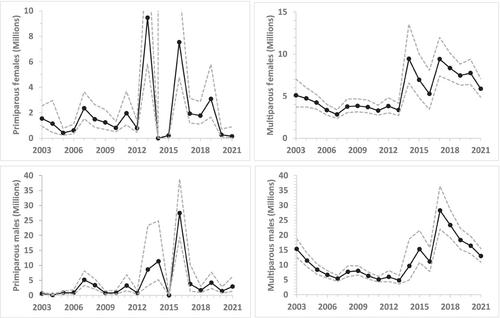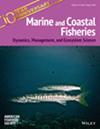Application of a catch multiple survey analysis for Atlantic horseshoe crab Limulus polyphemus in the Delaware Bay
Abstract
Objective
This paper applies a catch multiple survey analysis (CMSA) to Atlantic horseshoe crabs Limulus polyphemus in the Delaware Bay to generate robust population estimates for harvest management. Currently, horseshoe crabs along the U.S. Atlantic coast are harvested as bait for other fisheries and collected for their blood, which is used in a biomedical industry. The Delaware Bay is home to the largest population of horseshoe crabs and is a significant stopover for shorebirds to rebuild energy by consuming horseshoe crab eggs prior to completing their northward migration. To address this interrelationship, the Adaptive Resource Management (ARM) Framework has been used since 2013 to ensure that horseshoe crab harvest within the region takes into account the forage needs of migratory birds. Since its inception, the ARM Framework has used a single trawl survey's swept area-based population estimates of horseshoe crab relative abundance and a theoretical population model developed primarily from literature-derived values. With more data collected in the region in recent years and other sources of mortality that can now be quantified, a catch survey model can provide horseshoe crab population estimates going forward.
Methods
A CMSA was used to estimate male and female horseshoe crab population size for 2003–2021 using all quantifiable sources of mortality and three fishery-independent indices of abundance.
Result
The CMSA results indicated that adult abundance of male and female horseshoe crabs was stable from 2003 to 2013 and then began to increase through 2017, a result that is consistent with stock rebuilding following a period of harvest restrictions as recommended by the ARM Framework. Population estimates were lower in recent years but remained above the levels estimated before implementation of the ARM Framework. In 2021, the CMSA estimated that there were over 6 million mature females and nearly 16 million mature male horseshoe crabs in the region.
Conclusion
The CMSA provides the best and most comprehensive population estimates of horseshoe crabs in Delaware Bay and will improve modeling efforts within the ARM Framework going forward.


 求助内容:
求助内容: 应助结果提醒方式:
应助结果提醒方式:


